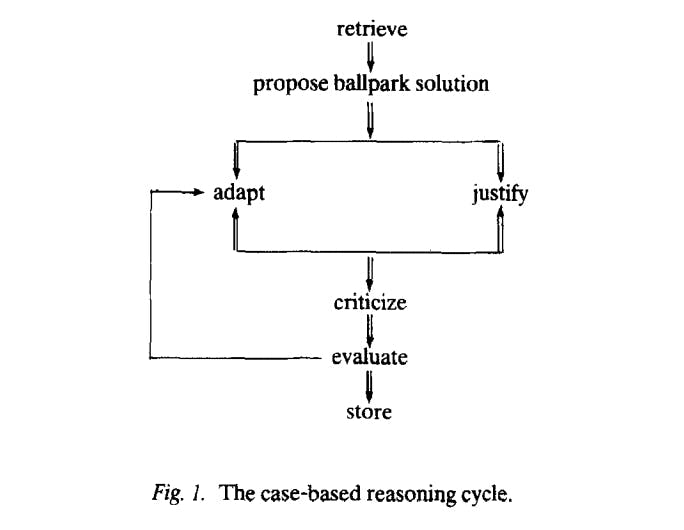Case-based Reasoning
The Basic Idea
How many times have your elders given you advice based on something they have experienced? “Well, when I was your age…”, “Back in my day, we did it like this…” It might seem like an annoying parental quirk, but it’s not that far off from the approach scientists, educators, and even computer algorithms use to solve problems.
Case-based reasoning is any kind of problem-solving approach that uses past solutions to solve similar problems. It assumes that knowledge can be acquired through past experiences, and can help warn you of avenues that will lead to failure or to help you think of successful past solutions that could be adapted to the problem at hand.
Case-based reasoning is all around us. For example, Google Maps uses case-based reasoning to tell you how long your journey will take by examining the patterns of past users to see how long it took them to get from point A to point B. Even if your path is from two slightly different points, it makes inferences on how long your journey will take.
Case-based reasoning can range from simpler tasks to complex computer algorithms. On one hand, it can be used to figure out something as simple as a cookie recipe. If you’re a fan of Friends, you may remember the episode where Monica tries to recreate Phoebe’s grandmother’s chocolate chip cookie recipe. She uses the failures of past batches to figure out a new solution to the problem, similar to a trial-and-error system.
On the more complex side of things, computers use a similar method to Monica. They categorize past problems and their solutions into ‘cases’, and then calculate how similar those cases are to the current problem to come up with a solution. This algorithm is common to examine patterns, diagnosis, trouble-shooting and planning.1
If we watch the way people around us solve problems, we are likely to observe case-based reasoning in use all around us. Attorneys are taught to use cases as precedents for constructing and justifying arguments in new cases. Mediators and arbitrators are taught to do the same. Other professionals are not taught to use case-based reasoning, but often find that it provides a way to solve problems efficiently.
– American computer scientist, Janet L. Kolodner2
Theory, meet practice
TDL is an applied research consultancy. In our work, we leverage the insights of diverse fields—from psychology and economics to machine learning and behavioral data science—to sculpt targeted solutions to nuanced problems.
Key Terms
Analogical Reasoning: a way of approaching a problem that assumes that because two (or more) things are similar in some respects, they are similar in other respects as well.3 Analogical reasoning is the basis of case-based reasoning, as it relies on the comparison between similar problems to be able to adapt to past experiences.
The Indexing Problem: having to find an experience which is closest to a new experience in memory. To do so, we have to index experiences properly in our minds to be able to recall them when necessary.2
Problem-solving style of case-based reasoning: a style of reasoning in which old solutions to old problems become the guide for solving new problems.2
Interpretive style of case-based reasoning: a style of reasoning in which new situations are evaluated in the context of old situations. These old situations help justify a new solution.2
Case-based teaching: while case-based reasoning asks an individual to use past experiences to come up with new solutions, case-based teaching asks instructors to use past entities or experiences to provide their students with knowledge that will help them approach new solutions.4
History
Informally, case-based reasoning has most likely been around as long as humans have been. Although today we have access to advanced tools and technology, it is not required to use case-based reasoning — only past experiences are needed. Formally, the roots of case-based reasoning are linked to American artificial intelligence theorist Roger Schank’s Dynamic Memory theory.
Roger Schank wrote a book in 1982 that formalized the theory of case-based reasoning, titled Dynamic Memory: A Theory of Reminding and Learning in Computers and People. Schank came up with a model of memory suggesting that humans learn based on the retention of experience, not the retention of logic. He said that “humans are not ideally set up to understand logic; they are ideally set up to understand stories.” 4 Schank used his dynamic memory theory to explain how computers and other forms of artificial intelligence understand language. According to Schank, algorithms rely on conceptual understandings of words to understand their meaning, which he called the conceptual dependency theory. That’s how computers are able to assign one meaning for two words or phrases, instead of coding them as completely separate terms. For example, ‘give’ and ‘transfer to’ are given the same meaning by computers.5
Following Schank’s dynamic memory theory and conceptual dependency theory, others began to develop models of case-based reasoning for machine learning. Each experience, just like each word, is turned into a more general concept, which allows similarities to be made to future similar, but not identical, experiences. Systems are then created, where machines could learn by acquiring new knowledge cases. The first case-based reasoning system was then developed by American cognitive and learning scientist Janet Kolodner and was called CYRUS: Computerized Yale Retrieval and Updating System.
Kolodner put forward the following case-based reasoning system:

Kolodner intended the system to represent both machine learning and a human information retrieval system. Similarly to Schank’s theory, Kolodner agreed that we had to move away from keywords for memory organization and instead rely on conceptual categories. Her theory was largely based on indexing as well: proper indexing is required for retrieval, which is the first step of the case-based reasoning process. CYRUS was built particularity to incorporate political information and events to be used by the U.S Secretaries of State.2 Kolodner also distinguished between two kinds of case-based reasoning: a problem solving style and an interpretive style.2
As an understanding of case-based reasoning through the lens of machine learning grew in popularity, other fields began to adopt it as a form of reasoning that could extend past computer thinking and apply to human thinking.
Consequences
Case-based reasoning can help solve problems more efficiently. For example, if you are struggling to solve a problem, others will often advise you to take a break and tackle it with fresh eyes later. Case-based reasoning, essentially, is looking at past problems and their solutions with fresh eyes and trying to apply them to a new situation.
Case-based reasoning recognizes that usually, the second time we approach a task we are better at it. We have some experience; we remember our mistakes and successes and proceed accordingly. There are various factors that can influence how effective one’s use of case-based reasoning is:
- Experiences: It is likely that the more you’ve experienced, the better you will be at case-based reasoning. If you’ve only cooked pasta once and try to whip up fettuccine alfredo, you only have one prior experience to use as a problem-solving tool. If you’ve cooked pasta 100 times, you have 100 pieces of evidence to work with.
- Creativity and innovativeness: Case-based reasoning is only going to be effective if you have the ability to consider creative ways to adapt past solutions to new problems. Even if you’ve had 100 experiences, tackling a new problem the same way that you’ve tackled an old one hurts your chance of success. Being innovative allows you to slightly adjust old tactics and consider new ways of solving problems.
- The ability to perceive new situations in light of old experiences: On a basic level, case-based reasoning requires one to be able to remember past experiences, so a decent memory is a condition for this problem-solving approach. For case-based reasoning to work, one must find comparisons between new problems and old problems. Drawing links between the two — whether it be similarities or differences — will help in identifying what tactics are going to be useful and which ones do not apply to the new situation. Indexing experiences in such a way that makes them easy to recall is important.
- An ability to evaluate: Being rational and logical when it comes to case-based reasoning is also important. You should be able to adequately evaluate how successful or unsuccessful past endeavors were to know which avenues are worth pursuing.2
Controversies
Case-based reasoning contrasts with other popular theories of how artificial intelligence functions. Knowledge-based reasoning, for example, suggests that having general knowledge of a problem or domain and drawing links between general ideas and specific problems is how computers and people arrive at solutions. Case-based reasoning, alternatively, suggests that we recall specific instances and use them to perceive the new problem.
Since case-based reasoning is based on anecdotal past experiences, it is very personal and deviates from facts and agreed-upon knowledge. This makes it not the best approach when working on a team. It also is liable to personal biases and memory as someone may think a past solution worked really well but it was actually only a good solution for them, or they may have recalled the past inaccurately. As well, the use of anecdotal evidence means that the success of the approach is difficult to evaluate.
There are four steps to case-based reasoning (Retrieve, Reuse, Revise, and Retain), and with each step comes the potential for error.6 Case-based reasoning also requires individuals to properly remember quite a few past experiences with high levels of accuracy — it is a bit like trying to memorize an entire scientific textbook rather than trying to understand various processes so that you’ll be able to apply them to future reasoning, which knowledge-based reasoning employs.
Case Study
Case-based Reasoning and Architecture
Just as fashion is recycled over the years, architects could use existing designs to solve current design problems. However, the issues that arise in design are often poorly defined or documented, making it difficult for future architects to identify what went wrong or to generalize the design to adapt it to future situations. In part, the reason that not many architectural databases exist is because architects are reluctant to share their designs and to learn from other people using case-based reasoning. Therefore, although existing designs could be useful tools through which to conceive of new designs, they are not often put to use. Just as indexing is important for general memory, indexing is necessary to be able to make use of past architectural designs.
Intrigued by the lack of properly indexed architectural designs, Katharina Ritcher, a biomedical researcher, studied a teaching project in Germany that used case-based reasoning as an educational tool for architectural students.4 Past designs were clearly categorized and labeled with various criteria to allow students to see which ones would be useful for their current project. A database was created, allowing participants to expand their knowledge through a historical lens of design and allowing teachers to use the database as a reference guide to illuminate and provide examples of their teaching.
The teaching project forced students to use an interpretive style of case-based reasoning, as students were instructed to only use past designs as inspiration that they could identify as having two innovative solutions. Thus, the students had to analyze past solutions, and could not simply apply them to new solutions. Since past designs are complete entities but also are not labeled with information on whether it was successful,(not full experiences) it was up to the student to determine and evaluate whether the design was viable.4
Ritcher found that since students had to use an interpretive style of case-based reasoning, it trained them to be good analytical thinkers. However, it also came with a host of problems. Students did not always know what they were looking for when they examined a past design, and it was not always easy for them to notice what the design problem had been, let alone whether the solution was successful. Still, Ritcher concluded that a database could be a useful tool for case-based teaching even if it was less successful for case-based reasoning.4
Related Content
Why Is The Backward Research Method So Effective?
When researchers use studies to understand real-life behavior, they are essentially using case-based reasoning: the data is used to understand the real world. However, results that are observed within an experiment are often difficult to replicate and don’t accurately capture human behavior. In this article, Uptal Dholakia notes the downfalls of applied reasoning and highlights a different approach: the backward method. The backward method asks researchers to spend time at the beginning of their research before the experiment begins to figure out how this data is to be used, which allows them to design experiments that are more likely to fulfill the needs of its purpose.
If you’re interested in finding out the behind-the-scenes of how case-based reasoning works, you should check out our Analogy reference guide. This guide outlines how the comparison of two things helps us to understand complex phenomena. Analogies can be useful argumentative tools because even if someone has little knowledge on a particular matter, you can compare it to something that they do understand — like using sports analogies to explain more complex scientific research.
Sources
- Definition of case-based reasoning (CBR). (n.d.). Gartner Information Technology Glossary. Retrieved August 27, 2021, from https://www.gartner.com/en/information-technology/glossary/cbr-case-based-reasoning
- Kolodner, J. L. (1992). An Introduction to Case-Based Reasoning. Artificial Intelligence Review, 6, 43-3. http://alumni.media.mit.edu/~jorkin/generals/papers/Kolodner_case_based_reasoning.pdf
- Küpers W. (2012). Analogical Reasoning. Encyclopedia of the Sciences of Learning. Springer, Boston. https://doi.org/10.1007/978-1-4419-1428-6_788
- Richter, K., & Donath, D. (2006). Towards a Better Understanding of the Case-Based Reasoning Paradigm in Architectural Education and Design. eCAADe 24 – session 5, 222-227. http://papers.cumincad.org/data/works/att/2006_222.content.pdf
- AI and Games. (2017, May 28). Case-Based Reasoning – AI 101 [Video]. YouTube. https://www.youtube.com/watch?v=8p7dzVSr4XU
- Bernstein, C. (2019, August 16). What is case-based reasoning (CBR)? Search Enterprise AI. https://searchenterpriseai.techtarget.com/definition/case-based-reasoning-CBR

